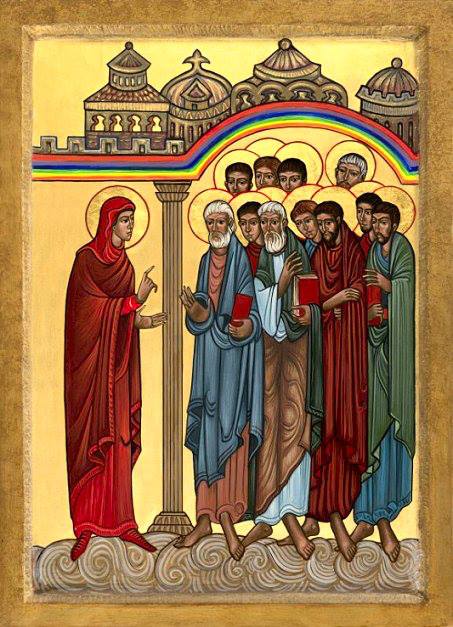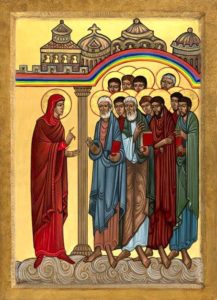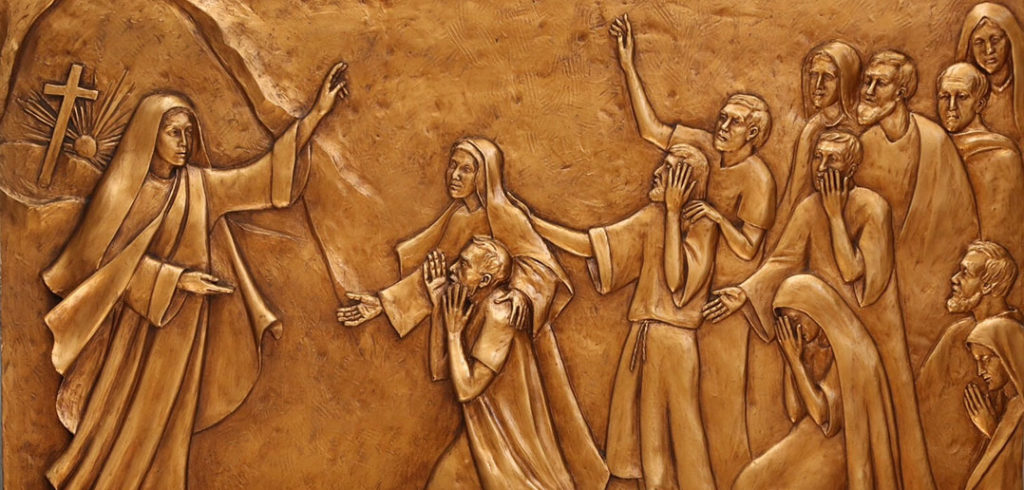Mary Magdalene With (Finally) Her Own Feast Day, July 22

I love the designated theme of this year’s Mary Magdalene Feast: “Celebrating Feminism & Faith in Union”. With this focus, how proudly we can join with other Catholic renewal groups in affirming the national and international Women’s Marches, #MeToo and #CatholicToo, all brave advocates for justice and rights of women, and those who participated in the March for Our Lives this past March. This theme perfectly highlights how critically our religious and other institutions need the focus and wisdom of feminist energy, and we proudly celebrate Mary Magdalene as a worthy inspiration.
 On that day, and all days, we also have a chance to celebrate all the Catholic renewal groups, especially FutureChurch, Women’s Ordination Conference, and Call to Action, in being instrumental in the correction of historical errors and promotion of historical truths that brought Mary Magdalene to the forefront as a saint worthy of not just a Memorial Day, as in the past, but her own special Feast Day.
On that day, and all days, we also have a chance to celebrate all the Catholic renewal groups, especially FutureChurch, Women’s Ordination Conference, and Call to Action, in being instrumental in the correction of historical errors and promotion of historical truths that brought Mary Magdalene to the forefront as a saint worthy of not just a Memorial Day, as in the past, but her own special Feast Day.
If you were not properly infused with Catholic liturgical teachings – or just were not paying proper attention in all those years of Catholic schooling! – you may have missed that in a calendar full of feast days, some are ranked as more important than others. In fact, there is actually a “hierarchy” – hmmm – of feast days, in this case with three different ranks: In third place are the “Memorials” observances of which can be “obligatory” or “optional”. Saint Mary Magdalene’s Memorial Day had at least been an obligatory day – one up from optional! – but still in the lowest rank.
Feast Days are the second in the ranking and generally honor events in the life of Jesus and Mary and saints of major importance. Mary Magdalene, in June 2016, finally made it to this, as it turns out quite important, middle tier. (Very few make the highest rank, “Solemnities” reserved for the most important events, Christmas, Easter, etc. and very few saints: Mary, Mother of Jesus, Joseph, John the Baptist, and Saints Peter and Paul.)
Who cares, you ask? For us and the Church, it may actually be a big deal. Of the thousands of saints, Mary Magdalene is one of the few honored with a Feast, and the only woman, other than Mary, Mother of Jesus. Since Feast Days are reserved for only the most significant saints, Mary Magdalene now stands with her equals, the other apostles and disciples of the Church. Her Feast now requires prayers and readings proper to her, and more “pomp and circumstance” in the Mass itself.
But most important is the new Preface the Church has sanctioned for the Saint Mary Magdalene Feast Day Masses because it proclaims the truth of her role both in the history and in the future of the Church:
In the garden He appeared to Mary Magdalene, who loved him in life, who witnessed his death on the cross, who sought him as he lay in the tomb, who was the first to adore him when he rose from the dead, and whose apostolic duty was honored by the apostles so that the good news of life might reach the ends of the earth.

This new Preface has the potential, not only to refute any leftover false impressions that Mary was a prostitute or public sinner, but to re-educate Catholics about who she really was. It accents her prominent and powerful place in the life of Jesus, her role as an apostle, and her mission, ordained by none other than Jesus himself, to spread the Good News of Easter. She is a woman ordained, and more and more will see and hear this truth every year. Even the entrenched hierarchy, perhaps?
I plan to attend a Mass led by a Roman Catholic Woman Priest to celebrate Mary Magdalene’s Feast Day. How amazing, today, to have that option. Whatever option we choose, though, I believe we will also celebrate the women who have gone before us, and we will stand in solidarity with women and men today to demand justice and inclusion.

2 Responses
Great accomplishment. Congratulations. It is needed.
After the resurrection and the ascension, the Church elected Matthias to replace Judas, and has since elected all successors to the apostles. Why is it that Matthias was chosen by the Church to be an apostle, and not Mary Magdalene? Because the witness of Mary Magdalene, or any other woman, was considered worthless.
After the resurrection, under the New Law, the Church is given full authority to mediate all vocations. By the power of the keys, the Church can ordain women at any time, without waiting for the Lord to return and give permission. It doesn’t make sense to say that the Church is not authorized to ordain women.
St John Paul II’s Theology of the Body, by shedding new light on the homogeneous consubstantiality of man and woman, which is not cancelled by their complementarity, provides the best tool for debunking the notion that apostolic succession is contingent on masculinity.